• National restrictions may apply, please consult government advice before planning travel
The big one: GR34 in Brittany
A whopper of a long-distance route, the GR34 in Brittany runs for more than 1,240 miles from the dramatic tidal island monastery of Mont-Saint-Michel all the way around the Brittany coast to Saint-Nazaire, where the Loire kisses the Atlantic.
Known as the Customs Officers’ Path – 18th-century, smuggler-thwarting coastguards made use of its clifftop views of bays below – it takes in everything that makes France wonderful, from beaches and foodie fishing villages to arty enclaves, stylish guesthouses and historical sites. Yet it’s only an hour’s drive from Saint-Malo (linked to Portsmouth by Brittany Ferries), showing that you don’t have to head south to get the best of the country.
For a bite-size section, head to pretty Perros-Guirec, two hours’ drive from Saint-Malo, being sure to try traditional galettes at Crêperie du Ranolien, before hiking the Pink Granite coast, with its rosy boulders reminiscent of Seychelles. Alternatively head for the Crozon peninsula, a three-hour drive cross-country from the port, for lovely swimming creeks and imposing headlands jutting into water the colour of mouthwash.
The island loop one: Belle-Île-en-Mer, Brittany
Who knew there was a tiny island paradise so close to home, where white sands meet turquoise waves, lighthouses decorate promontories and sweet seaside cottages are painted candy colours.
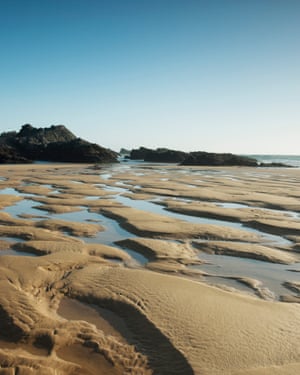
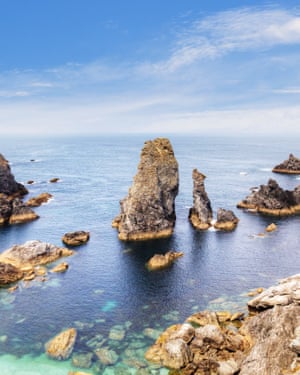
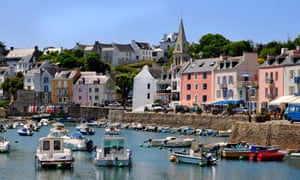
-
The Plage de Donnant, one of Belle-Île-en-mer’s sandy beaches; the Port Coton needles; pretty Sauzon, one of the island’s small harbours
A little like a French take on the Isles of Scilly, Belle-Île-en-Mer has long attracted creatives such as Claude Monet, who painted its imposing Port Coton needles, and one of the early stars of the screen, the bohemian actress Sarah Bernhardt, who moved into the military fort here in 1894, hosting glamorous parties, with Edward VII among her guests. The fort is now a little museum, in a beautiful spot on the Pointe des Poulains, one of the highlights of the 51-mile coastal path that circles Brittany’s largest island.
The path threads together the sheltered coves of the east, steep cliffs in the south, dunes for children to tumble down, and Le Palais harbour. Le Palais, the island’s main town, is where you’ll arrive if you take the hour-long ferry ride from Quiberon on the mainland. Ride the bus to different sections of the path and be sure to have an evening cocktail at Le Grand Large hotel, overlooking the sea.
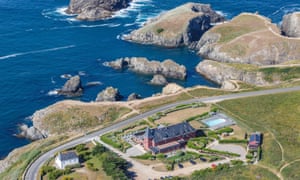
The magical forest one: Brittany’s mythical forest
Holidays to Brittany are very often all about the sea, but there are magical walking routes too in the interior’s marshes, forests and hills. Brittany’s once-vast forest of Paimpont, west of Rennes, is thought to be the one referred to in medieval folklore and myths as Brocéliande, an enchanted, fairy-filled forest associated with Arthurian legends. Today, themed trails and a museum at the Château de Comper bring the stories to life, adding an ethereal slant to family walks on the forest’s network of fern-lined trails. Your closest base could be Brittany’s vibrant capital, Rennes, an hour’s drive south from the ferry port at St Malo.
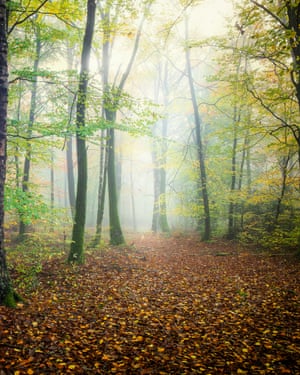
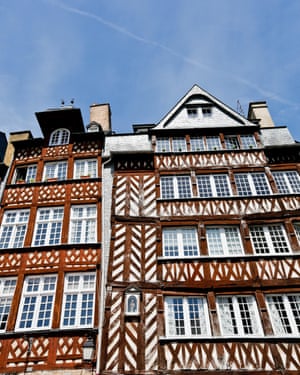
The dramatic one: Normandy’s Alabaster coast on the GR21
For anyone yearning to tackle one of Europe’s mammoth GR hiking trails there couldn’t be a handier starting point than that of Normandy’s iconic GR21, which begins in the city of Le Havre, arrival port for the Brittany Ferries crossing from Portsmouth.
Whether you ditch your car immediately and strike out to walk the full 115-mile route north to the fishing village of Le Tréport, which usually takes seven to 10 days, or drive to stroll shorter sections, is a matter for you and your thigh muscles to decide.
The geology of this stretch echoes that on the other side of the Channel, with dramatic high white chalk cliffs earning it the moniker the Alabaster coast.
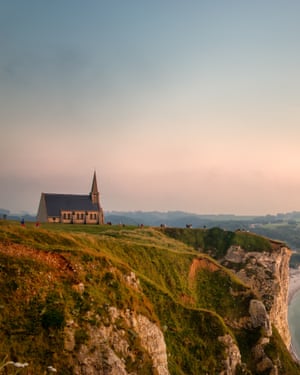
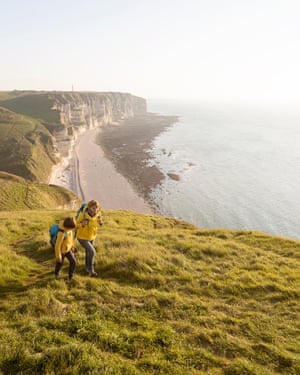
While the beaches of Normandy might still be associated with the noisy barrages of D-day, now only the wind tussling the leaves and the odd gull call will prick your ears, leaving mental space for contemplation on a peaceful route voted best hiking trail in France in 2019’s annual French Hiking Federation survey.
The path doesn’t always follow the coast due to the fragility of the cliffs, but descends often to beaches and villages tucked into ravines where rivers meet the sea, such as Fécamp, with an abbey, and Dieppe, with wonderful seafood restaurants. Look out too for second world war sites and Delacroix’s painting subject, St Pierre-en-Port. Just a little past Le Tréport, the lovely belle epoque seaside resort of Mers-les-Bains, with quaint bathing huts on a lively seafront, is a fabulous place to finish up.
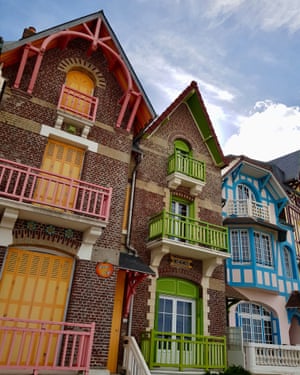
The boozy one: Normandy’s cider route
Whether you stagger it, swagger it or dart along like a teetotal hare, the 25-mile cider route is a beauty, connecting more than 20 cider farms in the lovely Pays d’Auge region of lower Normandy.
Densely wooded hills, villages of colourful timber-framed houses, chateaux and farmland comprise a gorgeous backdrop for immersion in the appley booze-making expertise of the area. You’ll learn to appreciate the slightly bitter flavour of local ciders – neither sandpaper dry or juicy-sweet – perfect for quenching the thirst of parched hikers. Calvados (apple brandy), sometimes mixed with apple juice to make pommeau, has to be tasted along with perries and cheeses. Where should you base yourself? Try any of the characterful hotels in ancient towns such as Cambremer.

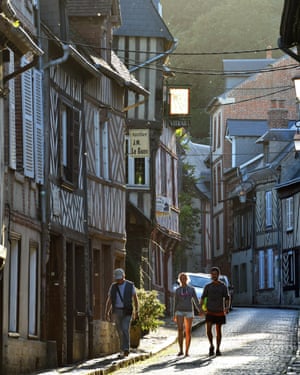
The cultural one: the Loire estuary
The Loire river may be most famous for the beautiful chateaux that decorate its banks, but many other interesting features lend it character as it wends its way west to the Atlantic. At its finale, a wide estuary forms a fascinating natural and semi-industrial environment that’s fun to explore on foot.
A 37-mile trail through the estuary from Nantes to the ocean, takes in fishing villages, nature reserves and a fantastic art trail, the Estuaire Nantes<>Saint-Nazaire, featuring 33 mind-bending sculptures, dotted along the water’s edge.
Picking out one section for a day’s walk, you might opt for the lively 11-mile stretch from Paimbœuf, a village of brightly coloured houses, to the seaside resort of Saint-Brevin-les-Pins, on the southern side opposite Saint-Nazaire. It offers sandy beaches, fishing huts on stilts and the art trail’s “Serpent d’Ocean” by Huang Yong Ping, a huge skeleton of a sea serpent submerged in the breakers that’s thrilling for children.
Alternatively there are dozens of other shorter walking trails of a few miles throughout the southern estuary area, which are easily doable for little legs.
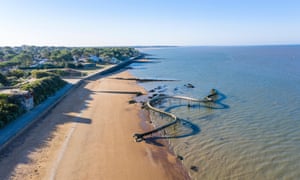
The hilly one: the Alpes Mancelles
For not-too-tough hiking challenges in a mountainous region that resembles a mini version of the Alps, head to the pretty Alpes Mancelles in the Atlantic Loire. The mountains here top out at only 200-400m, bless them, so are relatively easy to conquer, but will still earn you the kudos of having summited some of the highest peaks in western France. Le Mont des Avaloirs, at 416m, is the big boy of the region, providing wonderful views of the Sarthe river from a Brutalist-style concrete lookout point at the top.
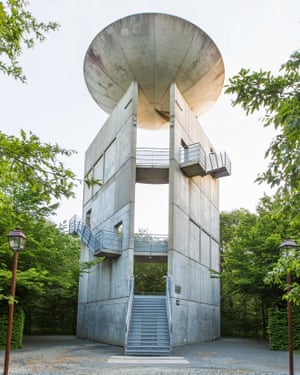
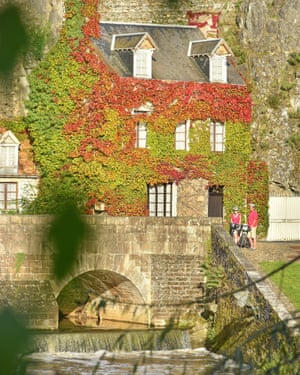
Across the unspoilt massif, hundreds of kilometres of paths explore wooded slopes and valleys, and loop from authentic villages such as Fresnay-sur-Sarthe, a medieval town on a rocky outcrop with a ninth century chateau to visit. There’s tons for families to do too, from hiking with donkeys to high-ropes courses in the trees.
Book your journey to north-western France at brittany-ferries.co.uk






